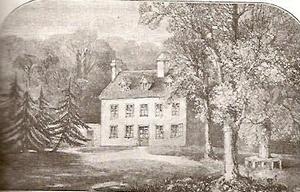
Steventon, an old print of the rectory where Austen lived (1775-99)
Real solemn history, I cannot be interested in…The quarrels of popes and kings, with wars or pestilences, in every page; the men all so good for nothing, and hardly any women at all — Catherine Morland, Northanger Abbey, Chapter 14)
Dear friends and readers,
The last week or so I’ve begun a slow return to Jane Austen’s novels. I’ve been so concentrating on her letters and biography, and before that the ignored poetry and manuscripts, that until I wrote my proposal for a paper to be given on the 4 Mansfield Park movies, and listened to Juliet Stevenson’s reading of Mansfield Park, I’d begun almost to forget these beloved texts.
First in an effort to return to teaching, but in a new way, no longer as an adjunct (invisible to, stigmatized in the department), I thought I’d try for positions in adult education, programs of non-degree courses, for retired people, continuing education for non-traditional students. And what did I come up with first: courses in Austen’s novels. Although I’ve taught these novels separately (well 4 of them, S&S, P&P, NA, Persuasion, twice each), and sometimes accompanied the text with a study of film adaptations, I’ve never taught a course in Austen’s work as such.
So I submitted proposals (limit of about 100 words) to teach Jane Austen in two different Oscher Institute of Life-Long learning programs, one for winter-spring (10 weeks), the other for the summer (6 weeks). I’ve been told the first “is certainly going to happen:”
Jane Austen, The First Half, or Steventon and Bath
This course aims to understand Austen’s 1st three published novels: Sense and Sensibility, Pride and Prejudice, and Mansfield Park through her artistic development; the places the books were written in; their first versions; and modern filmic takes. We begin at Steventon with a caustic (or rollicking) burlesque, Love and Freindship, and discuss letters in and letter-novels before reading S&S and P&P. After both, we watch Lee and Thompson’s S&S (1995 Miramax) and an excerpt from Andrew and Zeff’s Lost in Austen (2008 Granada TV). We move to Austen in Bath, and read her The Watsons, a realistic, grim fragment written there and brief excerpts from Lovers’ Vows and Thomas Clarkson on slavery as prologue to Mansfield Park. After MP, we watch Stillman’s indie, Metropolitan (1990), and learn about heritage and appropriation films. We end by comparing what films make visible about the way film-makers think readers read these novels and how these interpretations differ from grounded autobiographical, aesthetic, & historical readings.
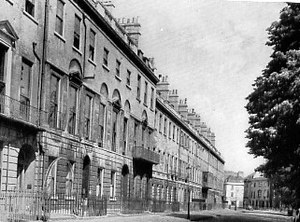
Green Park Buildings — one of the parades Jane lived in in Bath while her father still alive
[Bulletin update: 12/3/13: it’s been accepted! Good to go! Oh frabjous day!]
And I’ve returned to my calenders, “the important Tuesday,” and my book on Austen films. This is all interconnected. How? by re-reading Emma and starting a watch-through of the Austen films, beginning with the 1972 BBC Emma, scripted Denis Constanduros, directed John Glenister. I was not sure how much work I’d have to do on Emma‘s calendar, for I know the seasonal shaping and playful use of Tuesdays I found there is accurate and that this is not a novel revised from an epistolary narrative, not one which went through decades of revision (as did P&P, S&S and MP). So I had thought not much, but rereading I see how many references, tiny obsessive almost there are to time and space, and constant counting — we are continually given everyone’s ages, amounts of time events take in page after page, months, weeks, and there is not indication of this in my present timeline. There is a great deal about letters, they play a large role in the novel continually too still.
The 1972 film adaptation is so strong too because it’s a rare one for making irony continually central to all we watch, and the characters feel complex beyond their appearances. Of the faithful or heritage type one can follow the original plot-design, the script very good.
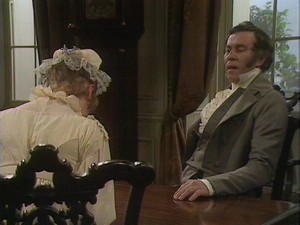
Mr Knightley (John Carson) and Emma (Doran Goodwin) discuss the novel’s first dinner party — one of many scenes of companionable dialogue and debate (1972 Emma)
And the theme of the heroine’s dearth of intellectual companionship except for Mr Knightley and then not consciously understood stares me in the face as well as the centrality of Harriet despite the turns at the volumes being where Frank Churchill comes and goes (as the turns in S&S are about Lucy Steele: end of Vol I, she is engaged to Edward, end of Vol II, she has an invitation to stay with the Dashwoods in London, end of Vol III she wins the new heir, Robert Ferrars).
In any case it necessitates a re-read! And I find I’m buoyed up by the fiction, just so rejuvenated and restored. I recently wrote:
I clearly love Jane Austen’s six major texts, and if I want to justify this to others, often talk of how I first read her at age 12-13 (P&P and S&S) and again at 15 (MP), so she is interwoven with my earliest traumas and if it’s true Doris Lessing might have done me more good, I didn’t know about her. I knew about Austen. And how I don’t read her for the romance at all, but the sentiments, thoughts of the text, narrator’s presence. A favorite line from P&P (and picked up as emphatic in the 1995 S&S) is that a basis for marriage is esteem and gratitude. Well I esteemed the Admiral and was intensely grateful to him. I also cling to her reasonableness, her steadiness, her sense of order and control. That way lies what peace there can be when alone. But not safety. Alas, not safety. Austen knew there was no safety for women.
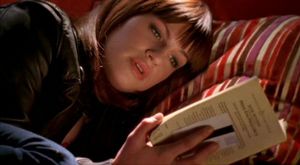
Amanda Price (Jemima Roper) loses herself in Austen
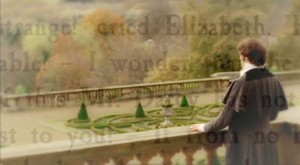
The male dream figure (Elliot Cowan as Darcy) seen through the novel’s text (2009 Lost in Austen)
And I’m also reading Catherine Schrine’s appropriation-sequel to S&S, The Three Weissmans of Westport am surprised to find how much I’m liking it. I find I prefer sequels _which don’t use the original characters or Austen and her family, but create a story that has analogies. Here instead of the shocking death with not enough money left at all, or the house (which was possible if you read carefully) as in S&S, a wife of 48 years is one day told by her husband he finds they have ‘irreconcilable differences.”
What!
Then it emerges he has a girlfriend, his assistant in the office and in a brilliant second chapter Fidelity (an ironic name) persuades the husband he should take the long-time apartment he lived with wife his wife on Central Park West from her. After all she never worked a day in her life for it, did she. It’s not known to the sisters or mother that the father has this girlfriend for sure, nor that she’s Fidelity. So the dramatic irony revelation will make Fidelity also analogous to Lucy Steele: and Fidelity has steel for a heart.
Each of Schrine’s characters who are analogous to Austen’s original only very slowly emerge; you can recognize the analogy and yet you have an original character. It’s witty and captures the quality of modern life for women. Elinor is now Annie, a librarian. Marianne Miranda, a literary agent who over-reached herself and was too trusting. Betty the mother Mrs Dashwood who didn’t pay attention to practicalities. Margaret is omitted – as she is in the 1983 movie. The analogous half-derelict house. Schine follows the structure and seasons of Austen’s book too, so now the three are set up in Connecticut in late August (not early September as in JA’s book)
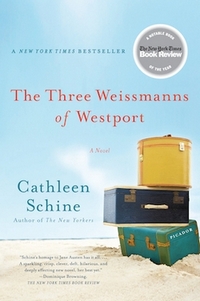
Angela Goddard’s cover — Schrine has embodied Diasporic Jane in this book
Schrine’s has a depth of feeling or maybe moral consciousness (I’m not sure what is the word – I like the characters I’m supposed to like?), is far enough away from S&S and yet you can follow the analogous plot-design as you go. One problem though is a retelling of it would inevitably lead you to tell the parallels in the stories and characters — rather like talking about a film where people point out differences and similarities. Maybe it’s too tethered like faithful heritage films — in feel or presence of writer and depth it is on a level of a Downton Abbey sequel I recently read: While we were watching Downton Abbey. While its author, Wax, is nowhere as ethical a presence as Schrine, Wax does create a fiction which is further away — as did Karen Joy Fowler (Jane Austen Book Club). More like an appropriation film.
What interests me though is that while Schrine is getting more and more place in the prestigious periodicals (she wrote the first article in the latest issue of NYRB), is strongly praised by respected people for some of her other novels (Barbara Kingsolver on Evolution of Jane), just about all the reviews on line that I read (blogs mostly) disliked the book, panned it. Readers expressed strong irritation. So I’m wondering if my reaction here is akin to the way I have reacted differently to a secondary heroine, Lady Edith of Downton Abbey, for along with a very few people I liked and sympathized with this character. The coming season (4) is advertised by Fellowes telling us what he likes about the central favored heroine, Lady Mary is she doesn’t need others to like her — a telling statement.
I’m almost keeping reading The Three Weissmans to try to guess or figure out what others didn’t like …
Ellen

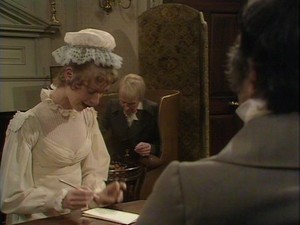
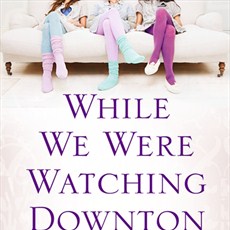
Someone has asked about my other proposal. It’s for a 6 week summer course and is a play on the same approach:
Jane Austen: the early phase
This course focus on Austen’s first published novels: Sense and Sensibility and Pride and Prejudice. Love and Freindship (a short hilarious burlesque which we will read first), Austen’s Steventon years, and letter fiction provide prologue and context for reading S&S and P&P. An alternative perspective provides the last phase of the course: Austen’s Bath years, a brief mid-career epistolary novel written there, Lady Susan (with an utterly amoral heroine), and discussion of how Austen revised the novels when she settled at Chawton. Last, we’ll see Ang Lee and Emma Thompson’s S&S (a 1995 Miramax product), and discuss what this film makes visible about the way film-makers think readers read these novels and how these interpretations differ from this course’s historical, autobiographical and aesthetic readings.